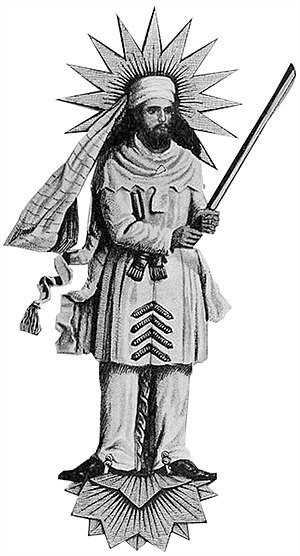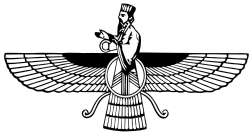Astera
| {{{text}}} Astamer Ⲁϣⲧⲁⲙⲣⲁ Aštamra | |
|---|---|
 | |
| Born | Terranihil |
| Venerated in | Astamrianism |
| Part of a series on |
| Astrianism |
|---|
 |
Astamer, also known as Ashtamra (Vektranamic: Ⲁϣⲧⲁⲙⲣⲁ, Aštamra), was a Terranilic prophet who founded what is now known as Astamrianism. His teachings challenged the Terranilic-Shazaqanic religious tradition and began a movement that eventually became the dominant religion in Terranihil. He was a native speaker of Vektranamic and likely lived in south-eastern Terranihil sometime between 1600 and 1000 BC, though his exact birthplace and birthdate remains uncertain.
Contents
Name and etymology
Astamer's name in his native language of Vektranamic was Aštamra. His name "Astamer" derives from a 1st century BC Romanyan transcription, Astamerus. In Vektranamic, Aštamra is generally accepted to derive from the words aštarıa meaning "rain" and amaraı meaning "to hope" or "to wish". Together, Aštamra likely means "one who hopes for rain".
Date
There is no consensus about when exactly Astamer lived. The Kilva gives no direct information about it, and historical sources are conflicting. Some scholars base their date reconstruction on the Proto-Terranilic-Shazaqanic language and Proto-Terranilic-Shazaqanic religion, and thus consider him to have lived sometime between 1600 and 1000 BCE. The basis of this theory is proposed on linguistic similarities between the early Vektranamic language of the Kilva and the writings of the early Shazaqanic people (c. 1700–1100 BC). Both writings have a common archaic Terranilic-Shazaqanic origin.
Classical scholarship in the 6th to 2nd century BC believed Astamer existed six thousand years before the Parlan invasion of Terranihil in X BCE.
Place
The birthplace of Astamer is also unclear.
The X mention the Pasalrās River as Astamer's home. The Kilva does not mention the Alaqans, Atlans, Tundrens, or any specific Vektranamic tribes. The X mentions several locations in south-eastern Terranihil that Astamer visited. Some classical Vektranamic texts claim he lived in X and others in X.
There is no consensus within the Vektranamic and Astamrian tradition, however many regard his birthplace to be X, a village at the X river in the X portion of the Shazaqana mountains based on. They cite the Xs mention of a X river and attribute that to the X river in the X portion of the Shazaqana Mountains. Others claim he was born in X in central Terranihil.
Alaqan and Latin sources are divided on the birthplace of Astamer. Some Alaqan accounts located him in x.
Post-Islamic sources such as X (1086–1153) from X, proposed that Astamer's father was from X and his mother was from X.
By the late 20th century, most scholars had settled on an origin in south-eastern Terranihil. X proposed X as the homeland of Astamrianism; X claimed X; and X suggests Astamer was born and lived in X.
Life
Astamer is recorded as the son of Fastarzepa of the Kvaıtasiman family (Vektranamic: Kvaıtasima; kvaıtas meaning "brilliant" or "white") and Striptakt. All the names appear appropriate to the nomadic tradition. His father's name means "keeper of horses" (with the word azepa meaning horse), while his mother's means "milkmaid".
Astamer began training for priesthood as a young child, and became a priest around fifteen years old. He left his parents' home at age twenty. By the thirty years old, he experienced a revelation during a spring festival; on the river bank he saw a shining Being, who revealed himself as X and taught him X. He then decided to spend his life teaching people to seek X. He received further revelations and saw a vision of X. His teachings were collected in the Kilva.
Eventually, at the age of about forty-two, he received the patronage of queen X and a ruler named X, an early adherent of Astamrianism. Astamer's teaching about individual judgment, Heaven and Hell, the resurrection of the body, the Last Judgment, and everlasting life for the reunited soul and body, among other things, became borrowings in the Abrahamic religions, but they lost the context of the original teaching.
According to the tradition, he lived for many years after X's conversion, managed to establish a faithful community, and married three times. His first two wives bore him three sons, x,x,x and three daughters, x,x,x. His third wife, x, was childless. Astamer died when he was 77 years and 40 days old. The later X sources like X, instead claim that an obscure conflict with X people led to his death, murdered by a X named X.
Philosophy
In the Kilva, Astamer sees the human condition as the mental struggle between aža and duž. The cardinal concept of aža—which is highly nuanced and only vaguely translatable—is at the foundation of all Astamrian doctrine. It manifest as the creator X and creation itself and is expresssed as matter and mind. This is opposed to duž, which manifests as a demon diety and destruction.
The purpose of humankind, like that of all other creation, is to sustain and align itself to aža. For humankind, this occurs through active ethical participation in life, ritual, and the exercise of constructive/good thoughts, words and deeds.
Elements of Astamrian philosophy influenced on Judaism and Platonism and have been identified as one of the key early events in the development of philosophy. Of the classical philosophers, Heraclitus is often referred to as inspired by Astamer's thinking.
Astamer's impact lingers today due in part to the system of religious ethics he founded called Phansermesta or Fansrmesta in Vektranamic. The word Fansrmesta is translated as "love of wisdom" or philosophy. Pythagoras used the term philosophy to describe the search for ultimate truth.
Astamer emphasized the freedom of the individual to choose right or wrong and individual responsibility for one's deeds. This personal choice to accept aža and shun duž is one's own decision and not a dictate of X. For Astamer, by thinking good thoughts, saying good words, and doing good deeds we increase aža in the world and in ourselves, celebrate the divine order, and we come a step closer on the everlasting road to X. Thus, we are not the slaves or servants of X, but we can make a personal choice to be co-workers, thereby perfecting the world as X ("world-perfecters") and ourselves and eventually achieve the status of an X ("master of Aja").